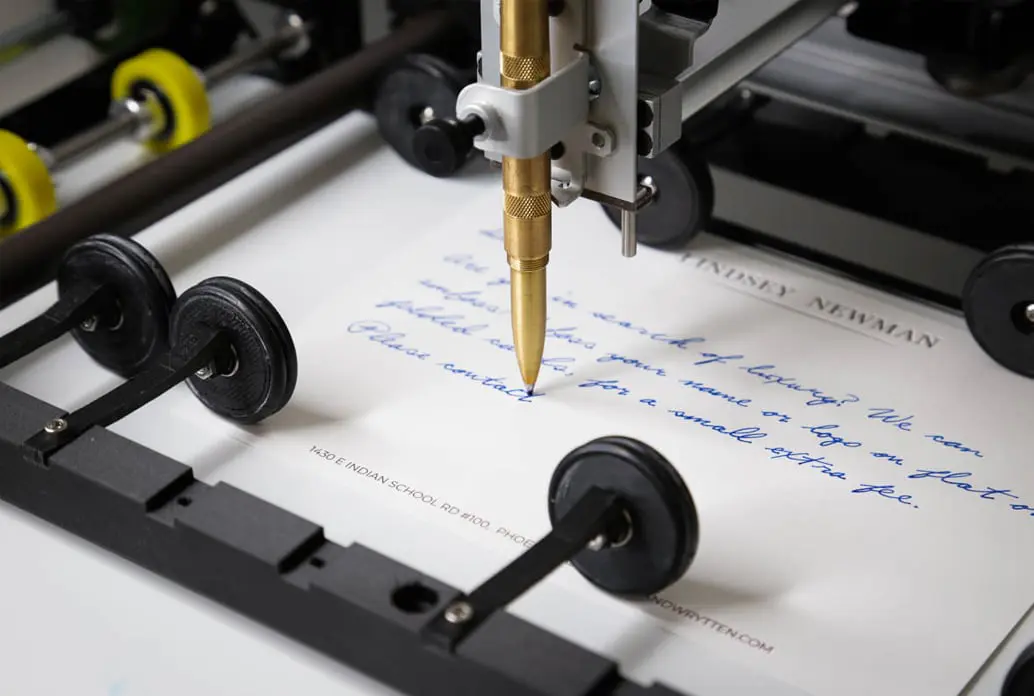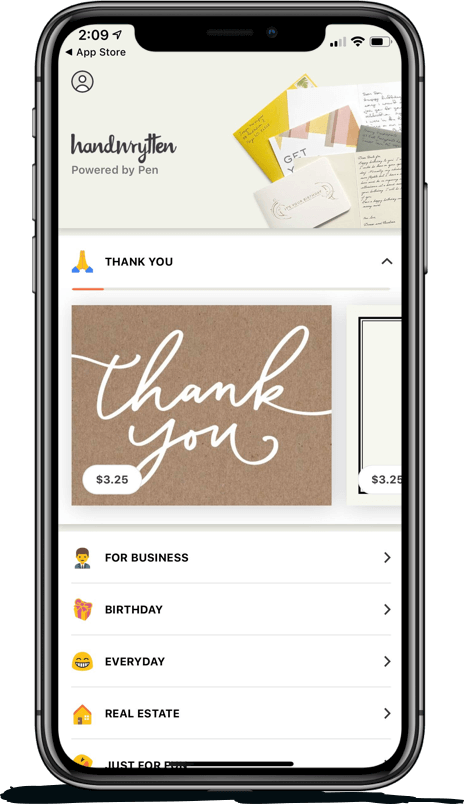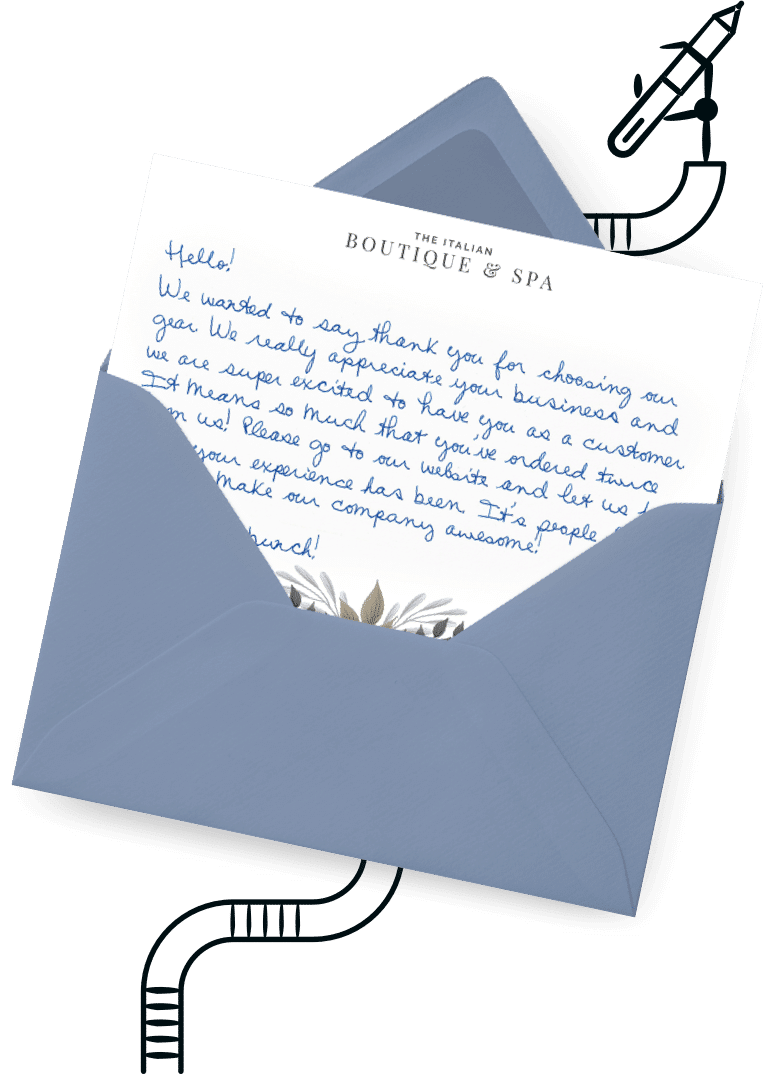
9280 S. Kyrene Rd.
Suite 134
Tempe, AZ 85284
Phone: +1 (888) 284-5197
Email: contact@handwrytten.com



You have been subscribed. Thank you!
Direct mail marketing includes the production and delivery of letters, postcards, magazines, and other materials by mail. While every business strives to get its own share of the online marketing space, too many businesses neglect the amazing potential of a great direct mail campaign. Sending direct mail communications to your audience is simple, reliable, and could turn a modest list of lead addresses into new, loyal customers.
Sending a letter or card is infinitely less complicated than learning the latest social media or search engine strategy. What matters is getting the basics of design and delivery perfected, which is not as complicated as you may think. Let’s get you up to speed on ways to not only compose a direct mail letter for your target customers but also speak in a way that engages with your business.
A great direct mail letter must actually be written by a pen — no exceptions.
A great direct mail letter must actually be written by a pen — no exceptions. Any attempts to digitally print letters in fonts that resemble handwriting, or mass-produce copies of a single multipurpose letter, will all be met with unremarkable results. Saturation is the reason. People are showered with junk mail that wasn’t created just for them. Responsiveness only becomes effective on a massive scale, which isn’t viable for many businesses. You’d be surprised at the attention-grabbing nature of real handwritten snail mail.
Today, people still read letters as long as they’re interesting and authentic. Think back to a time when you received a real handwritten letter in your mailbox and how clearly it stood out from everything else delivered that day. If you make this type of impression with every letter you send to every customer — as long as the customers are targeted and likely to care about what your business offers — lack of scale no longer matters. You’ll have an advantage that even the biggest and most prevalent direct mail marketers cannot overcome.
You or someone in your business’s marketing team doesn’t need to write every direct mail letter you create. A service such as Handwrytten will help you design, organize, and personalize letter campaigns, and written in the exact style you wish. Delivery and scaling are no problem with Handwrytten. You can achieve consistent quality with Handwrytten’s robots which use actual pens and don’t cramp up like human hands.
Too often, businesses take the concept of knowing their ideal customers at only a surface level, such as a fishing gear store targeting older men in their area. To maximize your direct mail results, you’ll need to approach your ideal customers in a way that interests them — not through flash or style, but by speaking to their needs. Know your ideal customer not through stats and demographics, but through desires, fears, aspirations, and frustrations.
Continuing with the fishing store example, let’s suppose the store knows that some of its customers visit when the store does not have a specific type of bait in stock. To remedy this problem, the store implements a fresh bait delivery service that uses dry ice. Many customers don’t know about this service. The store sends handwritten cards that follow a template of addressing recipients by name, apologizing for any inconvenient times when they couldn’t get the bait they needed, and introducing the online bait delivery option.
You may not operate a locally based fishing supply store, but the point is to find something specific to your customers’ needs and emotions, and use that “something” as the basis behind why you’re writing to your audience. You can create direct mail campaigns with simple offers such as discount codes, too, as long as they meet your customers’ needs at the time.
For example, a gift shop offering a generic 10% discount code is too broad to be interesting or feel targeted toward customers. If the discount code was specifically given on certain Valentine’s Day and romance-themed gifts, and only sent during the months of January and February, this effort would speak to customers who were wondering what to get for their significant other. The card’s content should be written with this sentiment in mind as well.
Being memorable isn’t easy, and cynicism is your No. 1 enemy. When people feel like you are simply another business, that you don’t care about them or don’t view them as equals, they won’t care what you have to say, no matter how eloquent your writing or persuasive your language may be. A great direct mail letter succeeds by disarming recipients’ cynicism, so let’s discuss a few ways to accomplish this goal.
Confessions, the giving of personal information about yourself, are more powerful than giving something tangible such as a gift or discount code. For example, an ice cream store that has opened its second location could send a direct mail card to its customers. In these handwritten notes, the company president confesses that when he began, he was an 18-year-old kid with a single ice cream truck, eating his own inventory because selling the ice cream was so difficult. The work was so rough that he sold ice cream during the winter to try to make ends meet. Thanks to customers who stuck with him, he was able to open his first store, followed by a second one. The president could state the store’s location, invite readers to visit, and offer an incentive such as a free ice cream cone as a thank you for helping him succeed.
What makes this story so interesting and believable? Since other businesses portray a constant veneer of success and perfection, this bit of vulnerability makes the president feel like a friend. It’s not uncommon for letters like this one to receive replies from customers who recall similar stories of their own struggles. Don’t you think a person who was moved to reply by your letter is more likely to be loyal to your business?
People can appreciate that running a business is hard, and they have no trouble believing such a story of hardship. After confessing something true and believable, your customers will have a much better likelihood of trusting you about other items you share with them.
We could discuss many other ways of being memorable and here are a few to consider and study:
Advice: Be a trusted advisor on a topic that matters to your customers. Give advice in a casual, neighborly way without talking down to them.
Target: Send a specific, smaller campaign to a particularly special group of customers, such as your most frequent buyers, to celebrate them in particular. Anyone can be a customer, but being a VIP is an interesting status that people don’t want to lose. Send thank-you cards to express gratitude and appreciation.
Knowledge: Offer special knowledge or secrets on a relevant topic. The fishing supply store mentioned earlier could include a map of the latest offshore fishing hotspots, for example. You could offer a simple bit of convenience, such as a store showing a new top-down map detailing how its products are shelved after making a change so that customers won’t be confused. Even something that small can create gratitude and help customers remember you.
You don’t want to get too held up on the specific words you use in your direct mail letter campaign template, but in general, you should write in a way that will apply to the most people possible. One word you can use nearly as much as you please is “you.” This pronoun is personal and breaks the ice, and it should not be neglected. Make sure you use the personal, singular “you” as well. Speaking too generally by addressing your audience in the plural completely deflates the personal nature of a handwritten letter.
You also want to know your target audience’s general reading level. If you write letters at the doctorate reading level to sound informed and trustworthy, but your audience doesn’t understand half of the words you’re using, your letter is not going to be read. When in doubt, underestimate your audience’s reading level and keep the structure simple. You’re not patronizing; you’re extending a courtesy toward busy people who are taking the time to read your letters.
In addition, resist the urge to wow people or shock readers into paying attention. Many forms of junk mail rely on shock, flamboyant colors and imagery, and other gimmicks, and you don’t want to be associated with these tactics. Unless you write in a specific niche that welcomes such behavior, don’t be crass or cheeky, and don’t rely on puns and other lame jokes.
Your letters should be readable and lacking in obvious errors, of course, but don’t be a perfectionist. In some cases, breaking a minor grammar rule, such as ending your sentences with a preposition such as “to,” can help your message feel genuine, like a conversation with a friend or relative. In other words, don’t fuss too much about where a comma belongs and other punctuation rules. Real handwritten letters are about heart rather than academic perfection.
Finally, the length will depend on the context, but your letters should be scannable. Someone who is too busy to read your letter immediately should be able to open it, quickly look it up and down for a few seconds, and understand what it’s about. This idea may sound counterintuitive — won’t people avoid reading it if they can instantly see what it’s about? They still may, but the effect is much better than the letter being too big and bloated so that people feel put off from reading it, then or later.
Fonts have a mysterious, but unmistakable effect on how we read sentences. Words that are serious will have their impact reduced by a silly and playful font, and vice versa. The font is a complex topic that deserves its own separate discussion, but here are a few guidelines:
Message: In general, the more perfect and articulate a font is, the more serious it seems. Billowy, elegant cursive fonts with densely-packed letters will lend credibility but might sacrifice friendliness and approachability. Compare this to the opposite, a print-style and slightly clumsy font like something Tom Sawyer would write.
Size: Fonts with more size difference between uppercase and lowercase letters will look a bit more proper and educated, while fonts with similar letter sizes in uppercase and lowercase will appear more casual.
Style: The forward lean of italic fonts makes things appear fancy and deliberate, while a thick, bold font makes the letters and words feel louder and more confident.
It all comes down to what you feel will best match with your target audience’s personality. It’ll take a little research and experimenting, but it’s better than taking a wild guess.
Today everyone logs onto their computer or grabs their phone and faces a tidal wave of emails, social media feeds, and notifications. There’s nothing wrong with using these methods for your business, but you could affordably expand your marketing efforts by sending your customers something physical that cuts through all the noise. Best of all, you now know the secrets to maximize your return on investment!
When it comes to getting good results in direct mail marketing, Handwrytten takes all of the complexity and frustration away. Handwrytten’s resources and structure allow your business to attract and retain clients and even automate sales through direct mail marketing, all without sacrificing the time and manpower you need for other aspects of your business. Our convenient API integration options with Zapier, MailChimp, and over 1000 other platforms can help you automate the system entirely. Take a look at what Handwrytten has to offer and use modern technology to market the old-fashioned way.


Scale your handwritten outreach, creating positive impressions and long lasting bond.
Sign Up Today!


Over 100 designs to choose from or design your own. Our online card customizer makes it simple.
Check Out Our Cards!





